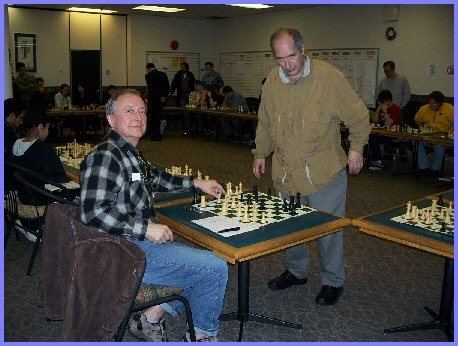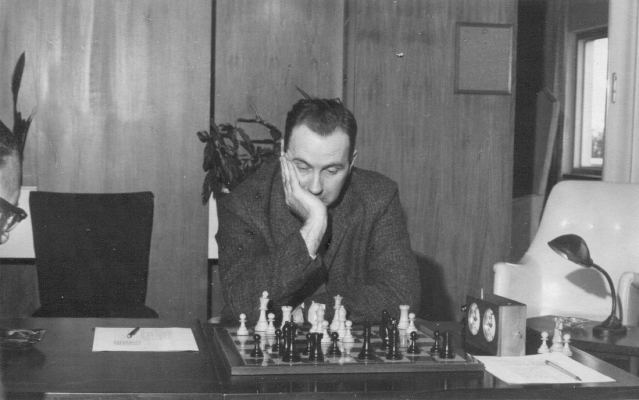Full name Duncan Suttles Role Chess Player | Name Duncan Suttles Country United StatesCanada | |
 | ||
Education University of British Columbia | ||
Lawrence day s best games vs duncan suttles
Duncan Suttles (born 21 December 1945) is a Grandmaster (chess) of chess who was the strongest Canadian player between the eras of Abe Yanofsky and Kevin Spraggett. He is one of the few over-the-board grandmasters who also holds the title of Grandmaster of International Correspondence Chess. Suttles has been inactive in over-the-board play since the mid-1980s. He currently serves with the software firm Magnetar Games, as President and Chief Technologist.
Contents
- Lawrence day s best games vs duncan suttles
- Mikhail Tal vs Duncan Suttles 1972 Sukhumi
- Early years
- Represents Canada
- Olympic stalwart
- Grandmaster
- Playing style and legacy
- Notable chess games
- References

Mikhail Tal vs Duncan Suttles, 1972 Sukhumi
Early years

Suttles was born in San Francisco, California, but moved to Canada at a young age, spending his formative years in Vancouver. He was of National Master strength by his mid-teens, which was unusual for Canadian chess at that time. His early mentor was mathematician and master Elod Macskasy.

Suttles made his first appearance in the Closed Canadian Chess Championship at Brockville, 1961, at age 15, and scored 3/11. Suttles won the British Columbia Championship in 1963 and 1966. In his second Closed, he scored 8½ from 15 games at Winnipeg 1963, finishing just above the middle of the strongest and youngest field yet seen in a Canadian final. Suttles tied for 3rd–5th places in the 1964 Canadian Open Chess Championship in Toronto, and as the top junior, qualified for the 1965 Junior World Chess Championship. At home in Vancouver for the 1965 Canadian Championship, Suttles scored 8/11 and finished second, behind eight-time champion Daniel Yanofsky. As a dual Canadian-American citizen, Suttles was also eligible for the United States Championship, New York City 1965–66, in which he finished last with 2½/11, an event won by Bobby Fischer.
Suttles attended the University of British Columbia, and represented the school in interuniversity chess competition. He earned his undergraduate degree in mathematics, and began doctoral-level studies, but did not complete his PhD.
Represents Canada
Suttles represented Canada at the Junior World Chess Championship, Barcelona 1965, but was drawn into a strong preliminary group which included the eventual winner Bojan Kurajica, and could only score 1½/4, failing to advance to the finals. Suttles did manage to win the 'B' final, ahead of Raymond Keene. Suttles represented Canada in the qualifying Interzonal event for the World Chess Championship at Sousse 1967, scoring 9½/21 for 15th place. Suttles won the Canadian Chess Championship held at Pointe-Claire 1969, after a playoff match with Zvonko Vranesic in Toronto, which Suttles won by 2½–1½. He took another crack at the Interzonal level at Palma de Mallorca 1970, scoring 10/23 for a tied 15–16th place, but did not qualify for the final Candidates' matches that would choose the title challenger.
Olympic stalwart
Suttles appeared at age 18 on the Canadian Olympiad team for Tel Aviv 1964, for the first of his eight selections, including six in a row, over a period of 20 years. He usually played a large number of games in these team events, close to the maximum. Here are his complete results; his totals for Canada in Olympiads are: (+49 −30 =43), for 57.8 percent. He also played board one for Canada on its bronze medal winning team at the 1971 Student Olympiad.
Grandmaster
Suttles became a Canadian citizen in 1966, and married his wife Dobrila in 1968; they have been together ever since.
Suttles was already of Grandmaster strength by 1968, and in fact qualified for the grandmaster title at the Lugano Olympiad. However, he was denied the title on the basis of a technicality, that he had played (and won) one more than the required number of games in the event. Instead, Suttles settled for the International Master title, earned in 1967 at the Sousse Interzonal. He finally achieved the Grandmaster title at the San Antonio tournament of 1972, gaining the last half-point he needed against Armenian Grandmaster and former world champion Tigran Petrosian.
He won the Canadian Open Chess Championship at Ottawa 1973. He also won the 1973 La Presse Open in Montreal. Suttles tied for first place in the U.S. Open Chess Championship at Chicago 1973, scoring 10/12 and defeating GM Walter Browne in the last round. Suttles placed clear second in the 1974 Canadian Open Chess Championship in Montreal with 9½/11, losing only to the winner Ljubomir Ljubojević.
He won the Western Canadian Open, Vancouver 1981, defeating Tony Miles and Yasser Seirawan in the final two rounds. He won his final Canadian event, the 1984 Vancouver Futurity.
While taking a break from over-the-board chess, he won a pre-computer era high level correspondence chess tournament, the Heilimo Memorial, played from 1978–1981. He was awarded the title of International Grandmaster of Correspondence Chess in 1982, making him one of the very few players to hold GM titles both for over the board chess and chess by correspondence.
Playing style and legacy
In his youth, Suttles was strongly influenced by Aron Nimzowitsch, and became well known due to his preference for hypermodern openings. He was perhaps the world's leading advocate of the Modern Defence from the mid-1960s, and showed that this line, a universal defence against any White opening move, was fully playable, which had not been the case before his time. The line was nicknamed the 'Rat', for the Black fianchettoed bishop which kept dodging around in its holes! As White, Suttles favoured 1.e4, with a predilection for the Closed Variation against the Sicilian Defence, and the baroque Vienna Game after 1.e4 e5. He occasionally played the English Opening (1.c4) as well. By the early 1970s, he was frequently opening with 1.g3 as White, aiming for a reversed Modern Defence, another new opening idea. His unique skills – such as the avoidance of main opening lines, use of a defensive kingside fianchetto, development of knights to unusual squares, and sudden eruption of tactics – are well illustrated by the selection of games listed below, which are all characteristic of Suttles at his best.
Suttles was the leader in a group of strong young British Columbia masters mentored by the veteran Macskasy. The players competed hard head-to-head, but also worked together, learned from each other, and employed original playing styles to largely dominate Canadian chess for the better part of a decade. Other members of this group from the late 1960s included Peter Biyiasas, Bruce Harper, Jonathan Berry, and Robert Zuk.
In the book The World of Chess (1974), authors Anthony Saidy and Norman Lessing described Suttles as the 'most original strategist since Nimzowitsch'.
A significant project, entitled Chess on the Edge, includes the largest annotated collection of his games, more than 600 in all. Simultaneous publication of the three volumes took place in March, 2008, with the publisher being the Chess'n Math Association. FM Bruce Harper, one of Suttles' students, led the effort, with assistance from GM Yasser Seirawan, Dutch IM Gerard Welling, and GMC Jonathan Berry.
